I heard and then saw a wood duck Friday morning at the Cedar Bluffs Natural Area. They are beautiful birds, and they nest in trees above water.
The wood duck is a medium-sized perching duck. The adult male has stunning multicolored iridescent plumage and red eyes, with a distinctive white flare down the neck. The female, less colorful, has a white eye-ring and a whitish throat. Both adults have crested heads.
They nest in trees near water. The one I heard this morning dived from its perch and flew down a ravine toward Cedar Creek.
The population of the wood duck was in serious decline in the late 19th century as a result of severe habitat loss and market hunting for both meat and plumage for the ladies' hat market in Europe. By the beginning of the 20th century, wood ducks had become rare, almost disappearing in many areas. In response to the Migratory Bird Treaty, established in 1916, and the enactment of the U.S. Migratory Bird Treaty Act of 1918, wood ducks finally began to repopulate. By enforcing existing hunting regulations and protecting woodland and marsh habitats, wood duck populations began to rebound starting in the 1920s. The erection of nesting boxes starting in the 1930s further assisted wood duck conservation.
Here is its call.
In 2019, Vernon Ashley, then 99, of Pierre, South Dakota, a former chairman of the Crow Creek Sioux Tribe and one of the architects of the tribe’s constitution, told the story of why the Wood Duck has red eyes.
He tells it above, and it is transcribed below.
“A lot of our legends are around animals in the old Indian storytelling. And, you know, there’s nothing in writing then, so everything was done by hearsay of mouth. They used animals for illustration. So when the wood duck got its red eyes, the main character is Iktomi.
Iktomi was a spider, but that’s not meaning the animal. Iktomi means a fellow that you meet every day on the street.
“My dad used to say he knew when election time came, a candidate would come, ‘Hello, my friend.’ He’d say, ‘He’s an Iktomi.’
“This story goes: It was a hard winter, so he hibernated. Come spring, golly, he stretched. He was hungry — real hungry. He was going to look for something to eat so he started to walk down by the creek. He heard something, he stopped. He could hear ducks playing in the water, playing in the water. He thought, Well, I’ve got to have one of them. So he got some pheží-šašà, this tall red grass. He got those, tied it in a bundle and threw it over his back.
“He walked near where the ducks were and angled off up the hill.
“The ducks seen him. ‘Iktomi!’
“He made off like he didn’t hear them.
“‘Iktomi!’“About the third time he stopped.
“‘Where are you going? What do you got on your back?’
“‘These are old songs,’ he said, ‘I’ve got on my back. I’m invited to a dance and I’m going to sing for the dance.’
“Some of the ducks said, ‘Sing for us!’
“So he thought about it. And he made them a little covered skin, the ducks made that, and one opening. And he got himself a small stick that he used, that was going to be his drumstick. “And so he lined up all the ducks around. When they started to sing he would go all around: ‘Dance with your eyes closed. If you open your eyes, your eyes are going to be red.’ So when he started to sing, some of these bigger ducks would come and he’d hit them over the head. The only one who opened his eyes was the wood duck. He said, ‘Open your eyes, he’s going to kill us!’ But they just beat him, beat Iktomi.
“And then when the ducks took off, why he picked up his ducks and went along the creek and built a little fire to hang some up so he could eat. And then he thought, Well, I’m going to have a little swim before I eat. And while he was swimming, he looked up, and there was a raccoon up in a tree eating his ducks. And so he still went hungry.”
Acrobatic tandem jumps.
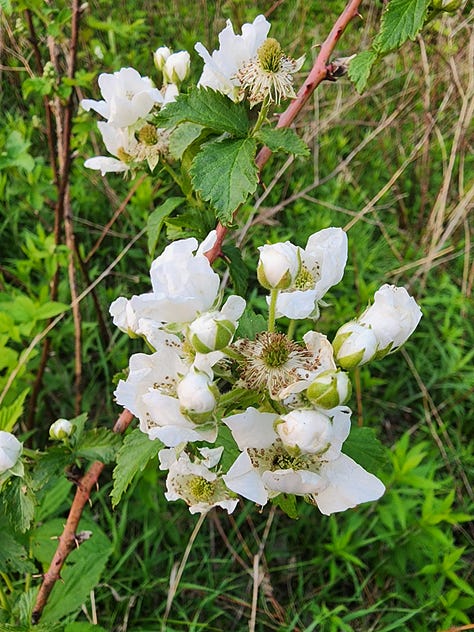
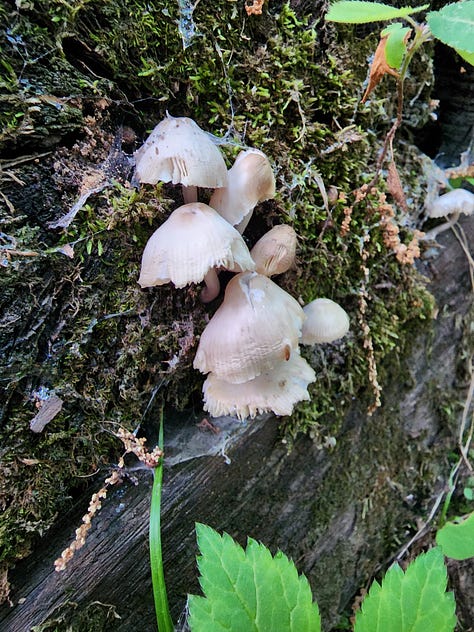
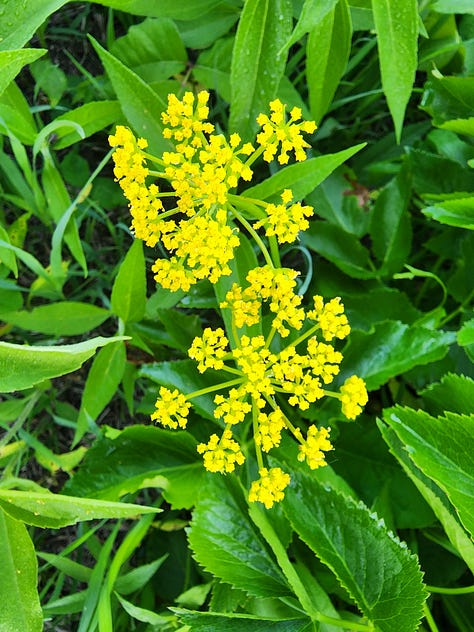
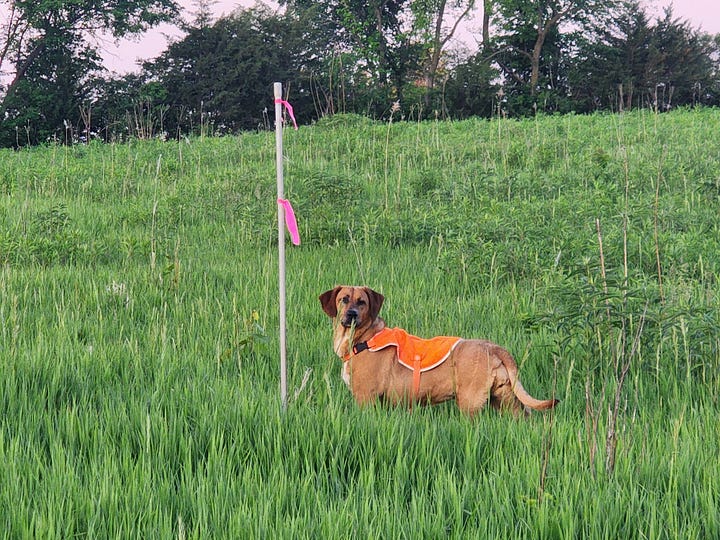
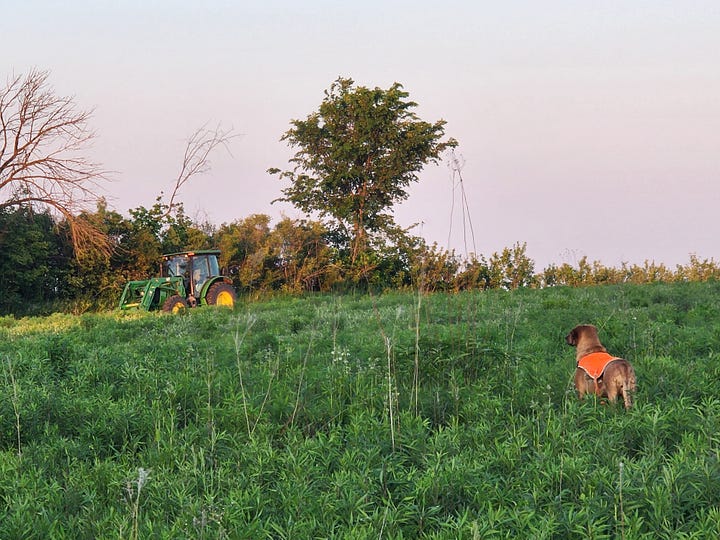
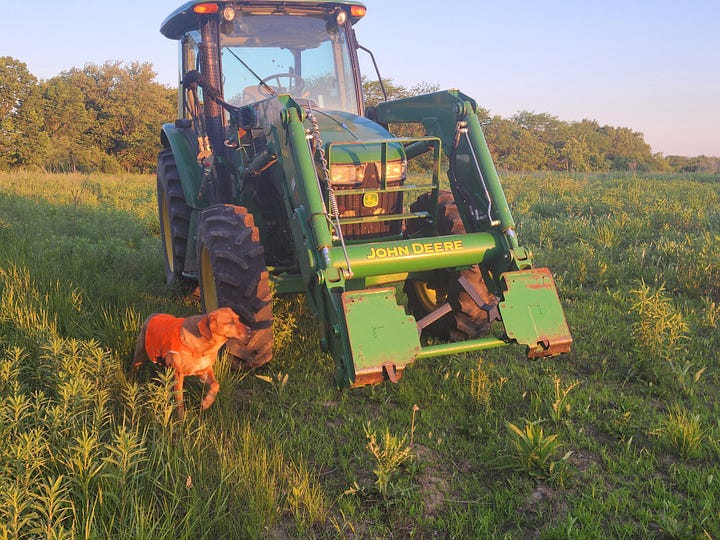
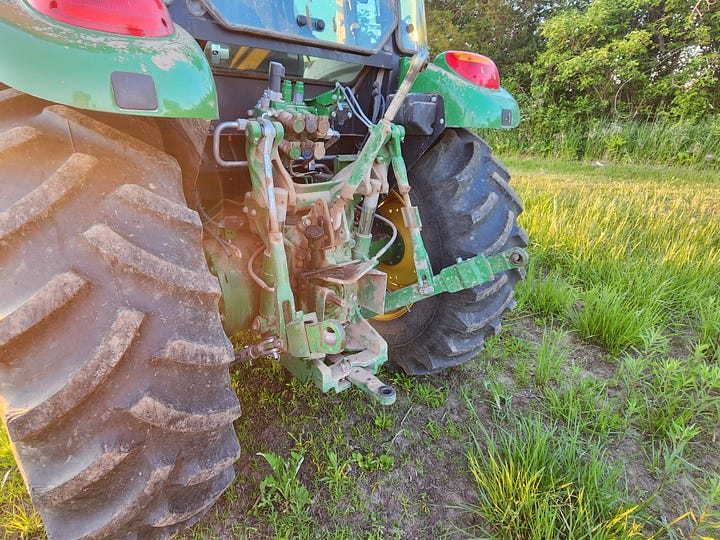
Our walk changes every day, but seldom do we see new human artifacts—especially big ones. Violet the Dog spotted what looks to me to be a surveyor’s stake in the prairie. Which, of course, suggests some construction is going to take place. The tractor was also new to that spot, which might be a coincidence. There were no implements attached, so who knows what’s about to happen?
While Violet the Dog was inspecting the tractor, I was wondering how old it was, how many drivers it has had, and what chores it could do. I said hello, tractor, but it didn’t answer.
As Violet the Dog and were contemplating all this, I flashed back to the television series Little Bear that the kids used to watch.
Set in the North American wilderness around the end of the 19th century, Little Bear goes on exciting adventures and learns new things with his friends Emily, Duck, Hen, Cat, and Owl. Mother Bear is a homemaker who looks after Little Bear, while Father Bear, a fisherman, is typically away on his ship, fishing.
I felt exactly like Little Bear on an adventure with Violet the Dog.
I’m a member of the Iowa Writers Collaborative. Please sample the talents of my fellow collaborative members. If you can afford to be a paid subscriber, that would be great. If not, the vast majority of content is free. And here is a link to the Iowa Podcasters’ Collaborative, should you be interested. Check out my Substack Deep Midwest: Politics and Culture if you aren’t already a subscriber. My Iowa Revolution podcast with award-winning broadcaster Spencer Dirks can be found here.
After spending nearly 20 years in radio, I know a little about public relations, and have started a small consulting group and associated Substack called Better PR. You might be interested in what I have to share there. Thanks!




